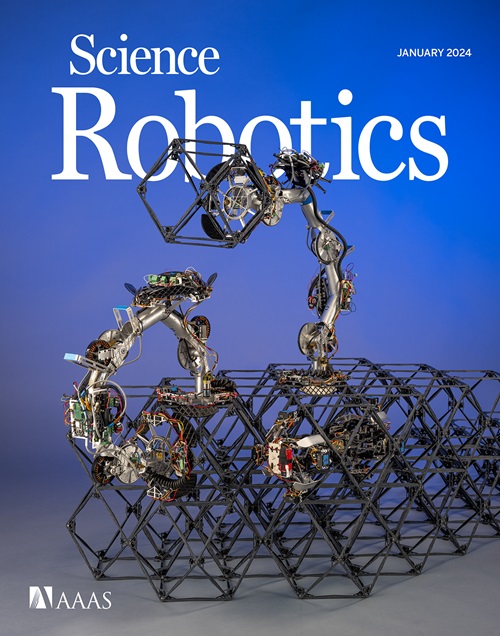通过对真菌菌丝体的电生理测量,实现对机器人的感知运动控制。
IF 26.1
1区 计算机科学
Q1 ROBOTICS
引用次数: 0
摘要
由于生命周期、对环境因素的敏感性以及严格的培养程序等方面的限制,活体组织还远未被用作生物杂交机器人的实用组件。在这里,我们引入了真菌菌丝体,作为生物杂交机器人中一种易于使用且稳健的活体组件。我们构建了两个生物杂交机器人,利用活菌丝体的电生理活动来控制人工致动器。菌丝体能感知周围环境,并向我们设计和制造的机器人的电机和阀门发出类似动作电位的尖峰电压作为控制信号。论文重点介绍了两项关键创新:第一,振动和电磁干扰屏蔽的菌丝体电气接口,可在不受限制的移动操作过程中进行稳定、长期的电生理生物电记录;第二,受神经中枢模式发生器启发的机器人控制架构,结合了来自活体菌丝体的正负尖峰的节律模式。我们利用这些信号控制了一个行走软体机器人和一个轮式硬体机器人。我们还利用紫外线刺激来增强机器人的步态,从而演示了如何利用菌丝体对环境线索做出反应。本文章由计算机程序翻译,如有差异,请以英文原文为准。
Sensorimotor control of robots mediated by electrophysiological measurements of fungal mycelia
Living tissues are still far from being used as practical components in biohybrid robots because of limitations in life span, sensitivity to environmental factors, and stringent culture procedures. Here, we introduce fungal mycelia as an easy-to-use and robust living component in biohybrid robots. We constructed two biohybrid robots that use the electrophysiological activity of living mycelia to control their artificial actuators. The mycelia sense their environment and issue action potential–like spiking voltages as control signals to the motors and valves of the robots that we designed and built. The paper highlights two key innovations: first, a vibration- and electromagnetic interference–shielded mycelium electrical interface that allows for stable, long-term electrophysiological bioelectric recordings during untethered, mobile operation; second, a control architecture for robots inspired by neural central pattern generators, incorporating rhythmic patterns of positive and negative spikes from the living mycelia. We used these signals to control a walking soft robot as well as a wheeled hard one. We also demonstrated the use of mycelia to respond to environmental cues by using ultraviolet light stimulation to augment the robots’ gaits.
求助全文
通过发布文献求助,成功后即可免费获取论文全文。
去求助
来源期刊

Science Robotics
Mathematics-Control and Optimization
CiteScore
30.60
自引率
2.80%
发文量
83
期刊介绍:
Science Robotics publishes original, peer-reviewed, science- or engineering-based research articles that advance the field of robotics. The journal also features editor-commissioned Reviews. An international team of academic editors holds Science Robotics articles to the same high-quality standard that is the hallmark of the Science family of journals.
Sub-topics include: actuators, advanced materials, artificial Intelligence, autonomous vehicles, bio-inspired design, exoskeletons, fabrication, field robotics, human-robot interaction, humanoids, industrial robotics, kinematics, machine learning, material science, medical technology, motion planning and control, micro- and nano-robotics, multi-robot control, sensors, service robotics, social and ethical issues, soft robotics, and space, planetary and undersea exploration.
 求助内容:
求助内容: 应助结果提醒方式:
应助结果提醒方式:


